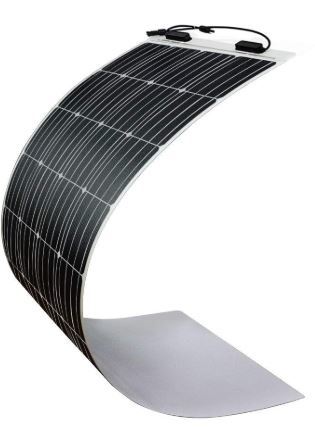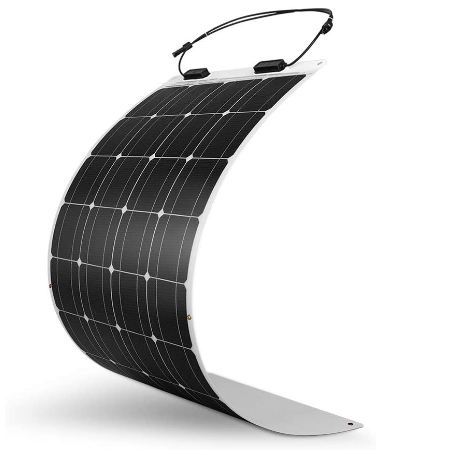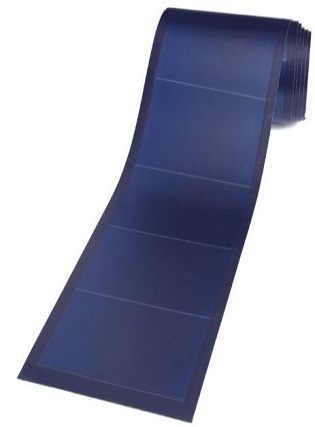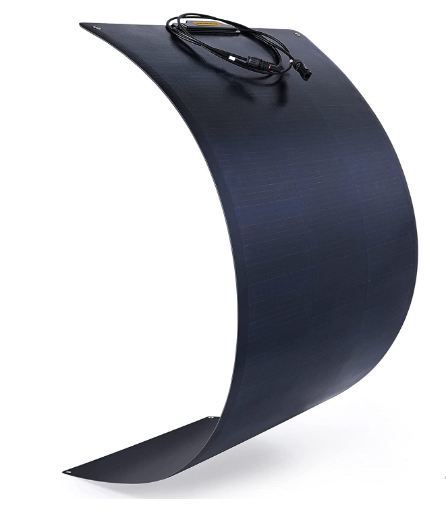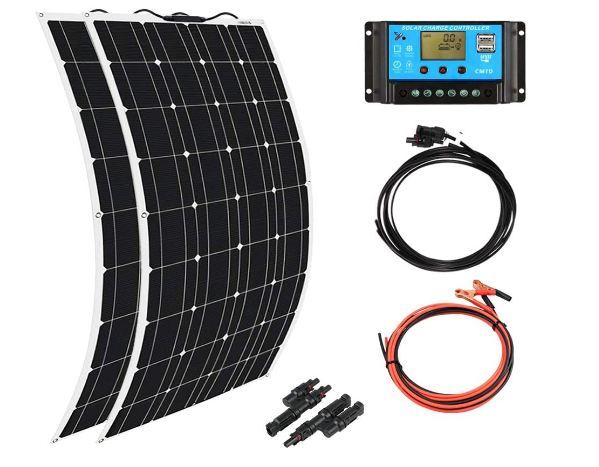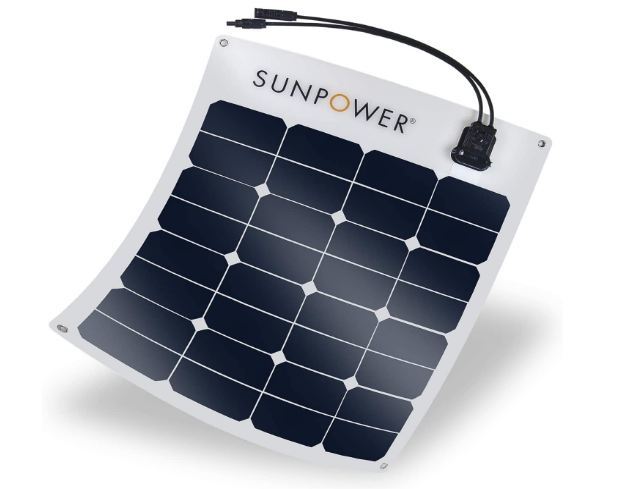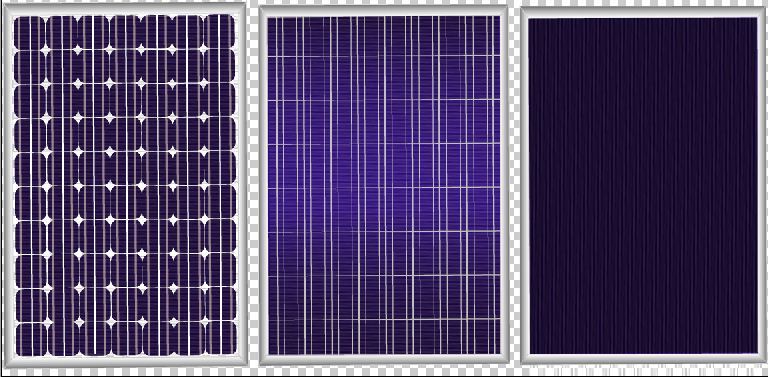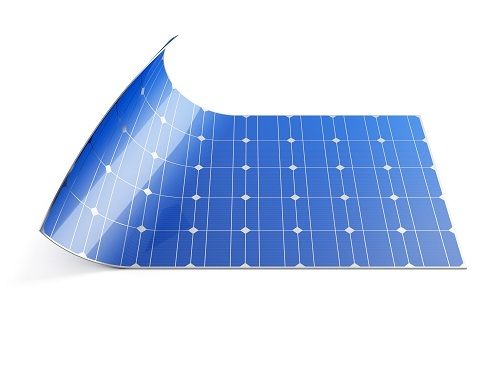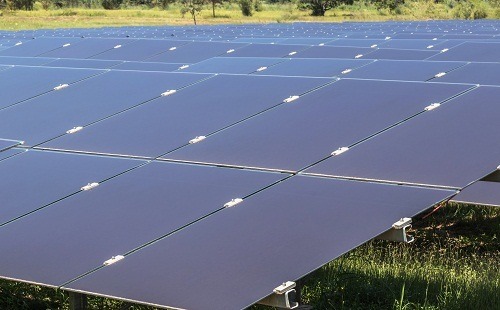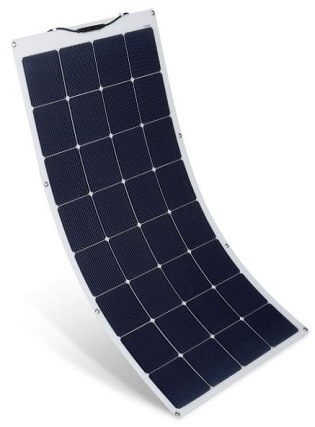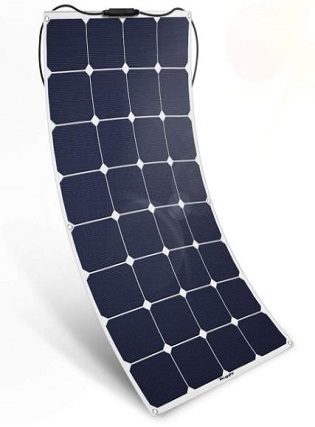There's been a lot of debate recently about flexible solar panels.
Some solar power experts claim they are inferior to traditional rigid panels. They cite stories about flexible solar panels quickly deteriorating or completely failing in just a few months.
While some of these problems are true and well-documented, there is good news as well.
Flexible solar panel technology has gotten a lot better.
Most bendable solar panels from reputable brands like Renogy work just as well as rigid panels today - and last just as long.
So if you are thinking about installing flexible solar panels on your RV, boat, roof or any curved surface where a rigid solar panel won’t do, go for it.
A quick check of customer reviews on the most popular brands on Amazon shows that most customers are happy with their purchases.
In this quick buying guide, I review the best flexible solar panels to help you find the best one for your needs.
But first a quick explanation about flexible solar panels and how they work.
What Are Flexible Solar Panels?
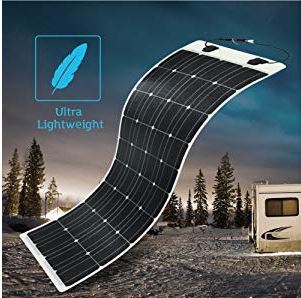
Flexible solar panels are exactly that…flexible. Unlike traditional solar panels that are thick and rigid, you can bend flexible panels.
They solve a major limitation of traditional solar panels.
You can mount them on curved or uneven surfaces where it would be difficult to install a rigid solar panel such as the top of RVs, boats and even trucks.
Flexible solar panels are also great for curved roofs and structures such as awnings.
You can also use them if your roof cannot bear the weight of a traditional solar panel.
One big advantage of flexible solar panels is how lightweight they are. This makes them perfect for portability.
If you spend a lot of time outdoors, a flexible solar panel makes it easy to have power on the go.
Best Flexible Solar Panels: Comparison Chart
- 1Best For RVs, Cabins and Boats: Renogy 100 Watt 12 Volt Flexible Solar Panel
- 2Best Rollable: Uni-Solar PVL-136 Power Bond Flexible Solar Panel
- 3Best Value: Sun Energise 100 Watt 12 Volt Flexible Solar Panel
- 4Best Solar Panel Kit: XINPUGUANG 200W Flexible Solar Panel Kit
- 5Best for Camping: ExpertPower 50W Flexible Solar Panel
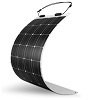
Renogy 100W

- Best for RVs, cabins, and boats
Output:
100W, 12VMonocrystalline
Type:
MonocrystallineWeight:
4.2lbsDimensions:
48 x 21.6 x 0.08 inWarranty:
5yr warranty
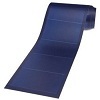
Uni-Solar PVL-136

- Best Rollable
Output:
136W, 24VCan be rolled up
Type:
AmorphousWeight:
17lbsDimensions:
216 x 15.5 x 0.2 inWarranty:
None
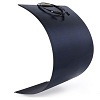
Sun Energise

- Best value
Output:
100W, 12VBendable to 30°
Type:
MonocrystallineWeight:
7.7lbsDimensions:
44.5 x 20.5 x 0.08 inWarranty:
1yr warranty
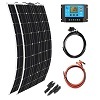
XINPUGUANG

- Best flexible solar panel kit
Output:
200W, 12VBendable to 30°
Type:
MonocrystallineWeight:
4.4lbs per panelDimensions:
46.2 x 21.2 x 0.1 in per panelWarranty:
Not specified
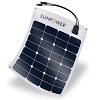
ExpertPower

- Best for camping
Output:
50W, 12VBendable to 30°
Type:
MonocrystallineWeight:
2.5lbsDimensions:
25.5 x 21.9 x 0.8 inWarranty:
5yr warranty
Best Flexible Solar Panels: Reviews
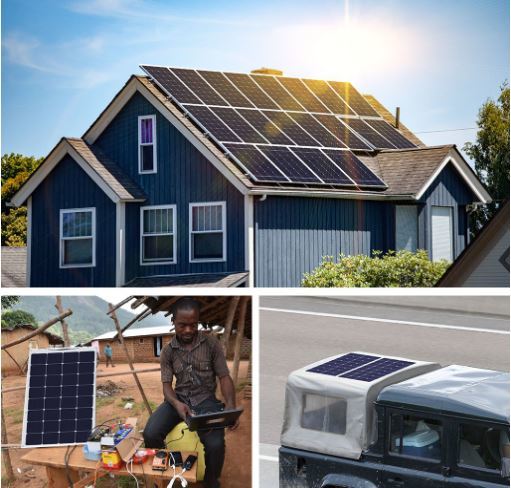
Here are our top five flexible solar panels.
If instead, you are looking for a complete solar generator for your RV, boat or camping see our backup and standby solar generator buying guide.
You can pair a solar generator with a flexible solar panel or two.
You’ll find them much more convenient compared to using rigid panels that are tedious to carry and require a flat surface to set up.
1. Best For RVs, Cabins and Boats: Renogy 100 Watt 12 Volt Flexible Solar Panel
Renogy flexible solar panels are some of the highest rated in the market. They’ve been proven to be just as reliable and efficient as traditional rigid solar panels.
The Renogy 100W 12V panel is a great choice if you are setting up a small solar system or want to charge a solar generator like a Jackery or Goal Zero Yeti.
Pros
Cons
Our Review
The solar panel is bendable up to 248 degrees, making it ideal for a van, boat, RV, trailer, and any curved surface.
Because the solar panel is designed to withstand heavy winds and heavy snow loads, you can use it in extreme environments. It’s also safe to leave it mounted at the top of your cabin or RV throughout, even in bad weather.
To make sure it is fully secure, we recommend installing it with adhesive (like Sikaflex-252) as well as screws. The solar panel comes ready with holes for the screws.
The Renogy flexible solar panel is also light, with each 100W panel weighing just 4.2lbs. So, if you want, you can set it up temporarily (instead of gluing it down) and move it as often as you need.
The Renogy solar panel has a max output of 100W and is designed to work with 12V systems.
If you need more power than this, you can string together two or more solar panels. You’ll need to buy a connector cable to pair the two solar panels.
Limitations
The cables included with the Renogy 100W flexible solar panels are short. You’ll most likely need to buy extension cables, especially if you plan to install the solar panel on the roof.
Summary
The Renogy 100W flexible solar panel is a great choice for anyone looking for a reliable, rugged and efficient flexible solar panel for an RV, cabin, teardrop trailer, boat or any curved surface.
Avoid it if you plan to install the solar panel on a flat surface. Get a regular rigid solar panel. It’ll be much cheaper.
2. Best Rollable: Uni-Solar PVL-136 Power Bond Flexible Solar Panel
If you thought the Renogy solar panel was flexible, wait until you read about this one from Unisolar.
It’s not only bendable; you can roll it up. When rolled out, it measures 18 feet long.
What we like most about this solar panel is that you can stick it on any surface. It adheres securely to metal roofs and on top of RVs and boats.
It’s a stick and peels solar panel. There’s no need for racks or mounts.
The roll-up solar panel produces up to 136 watts of power at 24V. That’s enough to keep a decent size battery charged.
The solar cells are designed for maximum efficiency.
Each cell has different layers that absorb blue, green, and red light. This increases performance in the shade and low light situations.
The cells can keep producing maximum power even when it gets really hot.
Most solar panels produce less power as it gets hotter.
The Power Bond solar panel maintains output, making it ideal for use in hot areas like Arizona and California.
The only major downside is that the solar panel doesn’t come with a warranty. That’s because the manufacturer went out of business a while back.
But customers say the panels are extremely durable and they’ve never had issues.
Pros
Cons
Specs |
|---|
Power: 136 watts Open circuit voltage: 24V (but can go as high as 30V) Dimensions: 216 x 15.5 x 0.2 inches Weight: 17lbs Warranty: None |
3. Best Value: Sun Energise 100 Watt 12 Volt Flexible Solar Panel
The Sun Energise 100W flexible solar panel is one of the best bargains we found. It offers the same output as the Renogy flexible panel, but at a lower price.
The tradeoff is that the Sun Energise panel is not as flexible as the Renogy one.
Pros
Cons
Our Review
The Sun Energise flexible solar panel offers plenty of power at a lower price compared to most other brands including Renogy.
The 100W max output is enough to charge a small battery bank or portable power station.
The Sun Energise flexible solar panel bends up to 30 degrees. That’s not as much as other brands, but it’s enough for installation on the curved roof of an RV, van, or trailer.
The solar panel comes with four metal-reinforced mounting holes at the corners for easy installation.
As long as you’ve installed the Sun Energise solar panel securely, it can withstand strong winds and heavy snow loads.
The junction box is waterproof (IP68), so don't worry about leaving it on the roof all year round.
The Sun Energise flexible solar panel comes with two MC4 cables, but they’ll likely not be long enough for your needs.
Get extension cables when you order the solar panel. If you plan to buy more than one solar panel, get Y branch connectors as well.
Limitations
Unlike the Renogy solar panel that bends up to 248 degrees, the Sun Energise solar panel bends only up to 30 degrees.
It’s not ideal for installation on extremely curved surfaces.
It’s also heavier, weighing 7.7lbs (compared to the Renogy’s 4.2lbs weight).
Summary
The Sun Energise flexible 100W solar panel is a great choice for anyone looking for a good deal on a flexible solar panel.
Avoid it if you need a highly flexible solar panel. Get the Renogy solar panel instead.
4. Best Solar Panel Kit: XINPUGUANG 200W Flexible Solar Panel Kit
If you are looking for a complete solar panel kit, we recommend the XINPUGUANG 200W flexible solar panel kit.
It’s ideal if you are setting up an off-grid solar power system in your cabin, RV, boat or van.
Pros
Cons
Our Review
A flexible solar panel kit is a good choice if you are setting up an off-grid system for your RV, van, trailer or cabin.
The XINPUGUANG 200W kit includes the following:
You’ll need to have your own inverter and, of course, a battery.
If the 200W output is not enough, there are additional options including 300W, 400W, 600W, 800W, and 1000W.
Setting up the system is pretty easy if you know the basics of solar wiring.
The solar panels have holes at the corners for securing on a surface. As for the wiring, the manual provides detailed instructions.
Limitations
The XINPUGUANG kit comes with a PWM solar charge controller, not the more efficient MPPT controller.
It works well, but you can get a lot more out of the solar panels by upgrading to an MPPT controller. If you get one of the larger kits, definitely upgrade to an MPPT solar charge controller.
Summary
The XINPUGUANG 200W solar panel kit is a great choice for anyone looking for a complete flexible solar panel kit.
Avoid it if you already have a solar charge controller and inverter.
5. Best for Camping: ExpertPower SunPower 50W Flexible Solar Panel
The ExpertPower SunPower 50W flexible solar panel provides enough power to charge a portable power station when outdoors.
It’s compact and ultra-light.
Pros
Cons
Our Review
Most campers don't need a 100W or 200W flexible solar panel. It’s too big (and expensive) for their needs.
If all you need to do is charge your portable solar generator, the 50W SunPower flexible solar panel is enough.
It’s perfect for small portable power stations with a capacity up to 300Wh. If you have something bigger like the Jackery Explorer 500 or the Goal Zero Yeti 500X, you can get two of the ExpertPower SunPower 50W panels and link them.
Alternatively, get the 100W option.
The 50W SunPower flexible solar panel is ultra-light, weighing just 2.5lbs. So you can even carry it on your hiking and backpacking trips and hang it from your backpack using the corner holes.
You can also set it up on a tent, van, or car.
The SunPower flexible solar panel comes with built-in MC4 cables but you may need to get extensions based on your camping setup.
The SunPower solar panel has a copper backing that protects it from corrosion and cracking. This ensures you’ll be using the solar panels for years.
The junction box has an IP67 waterproof rating, so rain damage is not a concern.
To back up the solar panel’s build quality, ExpertPower offers a 2yr product warranty and a 5yr power warranty.
Limitations
The SunPower flexible solar panel bends to just 30 degrees, so it may not work very well for extremely curved surfaces.
Summary
The ExpertPower SunPower 50W flexible solar panel is a great choice for campers and anyone looking for an ultra-light flexible solar panel that can charge a small portable solar generator.
Avoid it if you need a high-output flexible solar panel.
Flexible Solar Panels Buying Guide
Here are the most important factors and features to consider when buying a flexible solar panel.
Output
The most important factor when buying any kind of solar panel is output. The ideal output depends on the size of battery (or batteries) you need to charge and how quickly you consume the stored electricity.
If you want to charge a portable power station, a flexible solar panel with 100-150W in output is adequate depending on the total watt hours of the power station.
If you want to charge a large home backup battery, get a 150W-200W flexible solar panel. You can also get several 100W panels and chain them.
For RVs and boats one or two 100W-150W flexible panels are enough to keep you supplied with power.
Type of Solar Cells
Most flexible solar panels use monocrystalline solar cells. They are more efficient than polycrystalline solar cells and require a smaller surface area to produce the same amount of power.
A third type of solar cell design – amorphous solar cells – offers several advantages over poly and mono crystalline cells.
Flexible amorphous solar panels allow more flexibility, which is why the Uni-Solar PVL-136 solar panel is rollable, not just bendable.
Amorphous solar cells are also more efficient, though they require a larger surface area to produce the same amount of power. That’s why the Uni-Solar PVL-136 solar panel is much longer than the other same-output flexible solar panels.
Two other big advantages of amorphous solar panels is that they maintain output even in high temperatures (other solar cells reduce output when it gets hot) and have better low light performance, meaning you can charge your battery even when it’s cloudy or shady.
Panel Material
Look for a flexible solar panel made from ETFE (Ethylene tetrafluoroethylene). Unlike PET solar panels, ETFE panels can withstand high temperatures, harsh elements and a wide range of chemicals.
This makes ETFE flexible solar panels more durable and reliable. While PET panels have a lifespan of about 5 year, ETFE solar panels can last up to 10 years.
Flexibility
Check how bendable the solar panel is. Most flexible solar panels allow a bending range of up to 30 degrees. This is adequate for most curved surfaces on RVs, boats and homes.
If you want even more flexibility, you can find panels that bend even more (like the 248-degree Renogy solar panel in our reviews above) and some that can be rolled up.
Size and Weight
Make sure the solar panel will fit the space you have available. This is especially important when buying rollable solar panels that require plenty of space when rolled out.
If portability is important for you, look for the lightest flexible solar panel you can get with the right amount of output.
One of the lightest flexible solar panels is the 5.7lb ALLPOWERS 100W bendable solar panel.You can even carry two of them for more power and you would still be travelling light.
Battery and Charge Controller
Compatibility is important when setting up a solar kit. You need a solar panel that is compatible – in terms of power, current and voltage – with your battery and charge controller.
Check the max input wattage of your portable power station. Be especially careful when chaining several solar panels. You don’t want to exceed the max wattage.
Also, check voltage requirements. For a 12V battery, get a solar panel with a max output voltage of 18V. A charge controller will step this down to a safe 12V.
If you have an MPPT charge controller, you can pair a higher-voltage solar panel (e.g. 24V) with a 12V battery. The controller will convert the excess voltage into current.
Finally, check the max current (amps or A) and voltage (V) your charge controller can handle.
Allow a 25% margin for both current and voltage, since solar panels sometimes have higher output than what is stated.
So if your charge controller can handle up to 150V, get flexible solar panels with a max output of 112V.
Advantages of Flexible Solar Panels
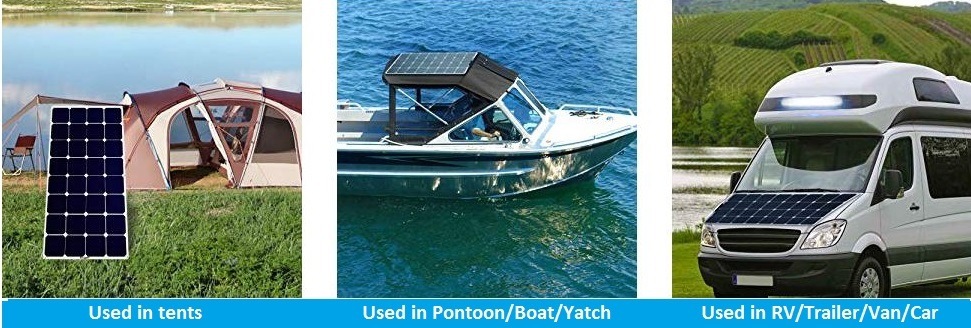
Flexibility: This one is obvious. Being bendable makes it possible to mount the solar panel on surfaces like the top of an RV, boat, or truck. You can even mount one on top of your tent when out camping.
Easy portability: Flexible solar panels are much thinner than traditional panels with most measuring just a tenth of an inch thick. This makes them very light. That, combined with their flexibility, makes it easy to carry them when going camping, for field work or on a road trip.
Easy to set up: It takes no more than 10 minutes to set up a flexible solar panel. The easy and quick set up is especially handy if you need to take it down and set it up daily or every few days (e.g., when camping).
Just as efficient as traditional panels: A 150W flexible solar panel is just as good and efficient as a 150W rigid panel. You don’t have to sacrifice power for flexibility.
Limitations of Flexible Solar Panels
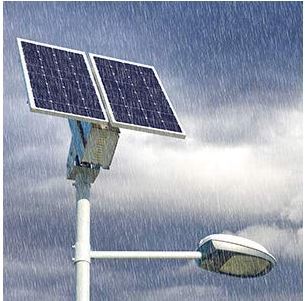
Not as durable as rigid panels: Though flexible solar panels have come a long way in terms of durability (modern ETFE can last 5-10 years) they are still not as durable as traditional rigid panels that can last up to 20 years.
Limited power output: Currently, it’s hard to find high-output flexible solar panels. The biggest ones top out at 150W. That’s why we recommend them for small scale systems in RVs and boats.
If you were to use them to power a home, you’d need a lot of them. That’s a problem because most manufacturers have a total system voltage limit meaning you can only connect a specific number of panels.
Flexible Solar Panels vs. Thin Film Solar Panels
Many people confuse the terms flexible and thin film solar panels. All thin film solar panels are flexible but not all flexible solar panels are thin film.
Thin film solar panels are an alternative technology to crystalline silicon solar cells (consisting of monocrystalline and polycrystalline solar cells).
Thin film solar cells consist of extremely thin photovoltaic materials (solar cells) made from cadmium telluride, copper indium gallium selenide or amorphous silicon among other materials.
These solar panels are much thinner than crystalline solar panels, and are therefore much more flexible. The only thin film solar panel in our buying guide is the rollable Uni-Solar PVL-136 solar panel which uses amorphous silicon solar cells.
Traditional crystalline solar panels have gotten much thinner thanks to technology. Four of our picks in the reviews above are flexible monocrystalline solar panels. However, they cannot match the flexibility of thin film solar panels.
That’s why you are unlikely to come across a rollable monocrystalline solar panel – for now.
It’s likely that in the future, as people seek clean and cheap energy in more applications, most flexible solar panels will utilize thin film technology.
Flexible Solar Panels vs Rigid Solar Panels
Flexible solar panels are bendable, allowing them to be installed on curved surfaces such as the top of a camper.
To make them flexible, they are very thin, with most measuring less than a tenth of an inch.
Rigid solar panels are the ones most people are familiar with. They are thicker and are covered by tempered glass. Most also have a metal frame.
Here are the biggest differences between the two types of solar panels.
Installing Flexible Solar Panels
Most solar panels come with metal-reinforced holes at the corners. Use those to secure the solar panel onto a surface using screws.
You can also use the holes to hang the solar panels on a tent, car, or backpack.
Another option is to glue the flexible solar panel onto a surface using industrial strength adhesive. In most cases, this is enough to secure the solar panel.
But if you are concerned about strong winds or heavy snow, you can use adhesive and screws.
Once you install the solar panels, you wire them the same way you would conventional solar panels.
Most flexible solar panels have integrated MC4 cables for connecting to the solar charge controller. But they are usually short. You’ll need extension cables to run from the roof of your cabin or RV to the solar charge controller mounted inside.
If you buy more than one solar panel, you’ll also need connectors to link them up.
Cleaning & Maintaining Flexible Solar Panels
Frequently Asked Questions

Are flexible solar panels good?
Flexible solar panels have gotten a lot better in terms of performance and durability. But they are still less efficient and durable than traditional rigid panels.
How much power do flexible solar panels produce?
It depends on the rated wattage. The most powerful flexible solar panels produce around 150-160 watts. If you want more power, you have to connect several panels.
How are flexible solar panels made?
Bendable solar panels are made by layering several layers of photovoltaic cells on a plastic backing. Most modern, flexible solar panels consist of monocrystalline layers on top of a durable ETFE (Ethylene tetrafluoroethylene) plastic.
How thin can a solar panel be?
Flexible solar panels can be incredibly thin with many measuring just 0.1 inches thick.
How much can I bend a flexible solar panel?
Check the manufacturer specifications. Most can bend to 30 degrees. The most flexible ones can bend until they almost make a complete cylinder while others can be rolled up.
How long do flexible solar panels last?
Modern flexible solar panels with an ETFE laminate last about 10 years.
How do you clean flexible solar panels?
Wipe clean with neutral soap and water. Use a soft non-abrasive cloth. To remove grease, bird droppings and other tough debris, wipe with methylated spirit.
Are flexible solar panels efficient?
Modern flexible solar panels match the efficiency of rigid solar panels – between 20% and 25% for monocrystalline solar panels.

